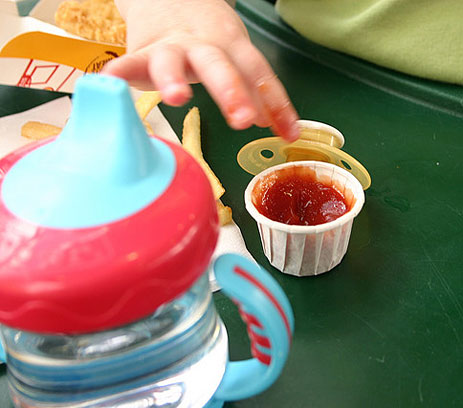 Photo: Oblivion999Last week, I praised fast food, which has probably been around as long as people have lived in cities.
Photo: Oblivion999Last week, I praised fast food, which has probably been around as long as people have lived in cities.
But there’s a particular type of fast food that goes back just a half-century, dating to the post-war rise of car-centered cities and suburbs. It relies on regimentation, weird additives, flavor “engineering,” super-cheap (but highly subsidized) ingredients, and super-expensive marketing. I won’t bore you with why I think this type of fast food sucks; wouldn’t want to be labeled a food snob!
But let’s talk about that marketing. Yale’s Rudd Center for Food Policy and Obesity has just put out an extraordinary report [PDF] on fast-food industry marketing.
Here’s the report’s headline number: $4.2 billion, which is how much the industry spent marketing its wares in 2010.
To put that amount in perspective, consider the Center for Nutrition Policy and Promotion, the USDA’s sub-agency that “works to improve the health and well-being of Americans by developing and promoting dietary guidance that links scientific research to the nutrition needs of consumers.” Its annual budget? $6.5 million, according to The New York Times reporter Michael Moss.
So $4.2 billion vs. $6.5 million. That means that for every $1 the industry spends haranguing Americans to eat stuff like Burger King’s 2,500-calorie Pizza Burger, about a tenth of a penny gets spent urging folks to eat their spinach.
And of course, as Moss’ superb recent piece shows, the USDA also openly collaborates with the industry to cajole people to eat more corporate fast food.
A $4.2 billion marketing budget in 2009, a year characterized by a brutal economic slump, is the sign of an extremely profitable industry. Corporate fast food is what is known as a “countercyclical” industry — it tends to thrive when the economy goes to hell. When money is tight, McDonald’s dollar menu looks like a bargain — and stuff like Domino’s now-infamous eight-cheese Wisconsin Pizza seems like a reasonable indulgence.
How well are these companies doing? The stock market gives us a clue. Over the past two years, shares of Yum! Brands (owner of owner of KFC, Pizza Hut, Taco Bell, and Long John Silver’s) and McDonald’s have both more than doubled. Meanwhile, the overall stock market, as measured by the S&P 500 index of the nation’s largest publicly traded companies, has flat-lined. In other words, investors are quite bullish on junk food corporations.
When times are flush, the industry is using its $4.2 billion marketing stash largely to cultivate new generations of customers: i.e., kids. The Rudd report doesn’t estimate how much of the fast-food industry’s marketing budget is directed at children (a 2006 study estimated a tidy $1.6 billion), but it offers a dizzying array of data to demonstrate the industry’s devotion to this dubious cause. Get this:
The average preschooler (2-5 years) saw 2.8 TV ads for fast food every day in 2009; children (6-11 years) saw 3.5; and teens (12-17 years) saw 4.7.
People have been scolding the fast-food industry for marketing its wares to kids for years. The industry’s response? A ramped-up effort to market its wares to kids:
Compared to 2003, preschoolers viewed 21% more fast food ads in 2009, children viewed 34% more, and teens viewed 39% more. … McDonald’s and Burger King have pledged to improve food marketing to children. However, both restaurants increased their volume of TV advertising from 2007 to 2009. Preschoolers saw 21% more ads for McDonald’s and 9% more for Burger King, and children viewed 26% more ads for McDonald’s and 10% more for Burger King.
There’s also an uncomfortable racial aspect to fast-food marketing — these companies evidently see major opportunity in selling product to African-American and Hispanic families:
McDonald’s and KFC specifically targeted African American youth with TV advertising, websites, and banner ads. African American teens viewed 75% more TV ads for McDonald’s and KFC compared to white teens.
How is all of this marketing working? The proof is in the whining. In a survey commissioned by the Rudd Center, 40 percent of parents report that their children ask to go to McDonald’s at least once a week, and 15 percent of parents of 2- to 5-year-olds report that their children harangue them for a Mickey D’s trip every day. As a result:
Eighty-four percent of parents reported taking their child to a fast food restaurant at least once in the past week; 66% reported going to McDonald’s.
What to make of all of this? To me, it underscores the importance of the National School Lunch Program. School lunches are our society’s most concrete, tangible way of transmitting foodways to rising generations. The public-school cafeteria is where we create a public vision of what the food system should be. In short, it’s the public contribution to the formation of kids’ eating habits. And it is in the cafeteria, I think, where the fast-food industry’s marketing efforts could be effectively rebuffed.
Unfortunately, I don’t have much good news here, either. Currently, we spend about $11 billion annually on school lunches — of which two-thirds goes to overhead and labor costs. That leaves about $4 billion to spend on ingredients — roughly equal to the fast food industry’s marketing annual budget. Per child, schools have about 90 cents per day to spend on ingredients.
At those levels of funding, it’s no wonder that public-school administrators are increasingly outsourcing cooking to … the fast-food industry, which knows a thing or two about engineering low-quality ingredients into something people will crave. And guess what? The USDA is cheering them on. Listen several minutes into this boring radio clip, and you’ll hear a Domino’s exec babbling about how USDA officials are helping the company get its pizza into school cafeterias. And if that doesn’t kill you, here’s a report about a Connecticut town that has invited McDonald’s PR flacks into its public schools to provide nutritional counseling.
There are school districts that are trying to teach kids other visions of what food is. Grist contributor and parent-turned-school-lunch-activist Ed Bruske is writing about the one in Boulder, Colo., right now — and how it’s struggling to balance the budget after tossing the junk food out.
Meanwhile, San Francisco is about to become the first major city to ban chains from providing toys in certain fast-food meals. The measure has arous
ed scorn — what will San Francisco ban next? the Times’ Freaknomics blog asked. But when cash-strapped parents and school districts are up against $4.2 billion in carefully plotted ways to get kids to beg for fast food, any public effort to fight back seems welcome.




